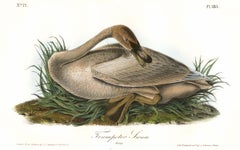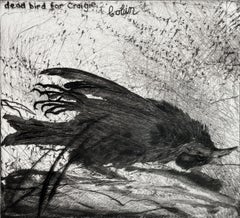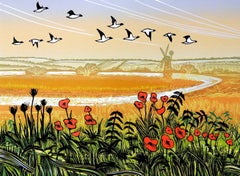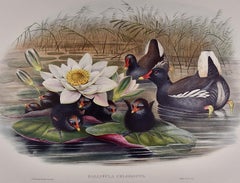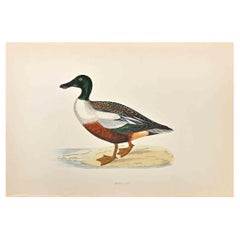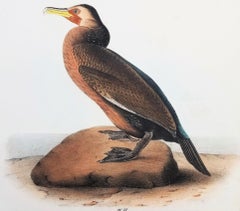Bird Animal Prints
to
112
903
218
246
65
40
Overall Width
to
Overall Height
to
525
308
33
31
23
20
18
9
8
4
3
2
2
56
41
33
26
17
131
622
426
293
3
3
8
21
16
14
19
122
74
13
122
763
629
67
2,731
1,769
1,472
1,076
867
544
498
448
444
400
356
355
336
248
235
189
174
150
142
141
444
334
280
264
87
117
769
562
483
Art Subject: Bird
Trumpeter Swan. (Young).
Located in New York, NY
Original stone lithograph with hand-coloring from "Birds of North America." First Octavo Edition, by John James Audubon. Plate 383. Philadelphia, J.T. Bowen, ca. 1839-44.
Category
1870s Animal Prints
Materials
Paper
Dead Bird for Craigie No. 2
By Colin Self
Located in New York, NY
A contemporary of David Hockney and Peter Blake, Colin Self is an important British printmaker whose innovative etching techniques and novel use of found materials have defined his diverse oeuvre. Yet unlike most artists associated with Pop Art, Self eschewed glossy, colorful bombast for nuanced drawings in a limited palette. Self's imagery has ranged from the geopolitical -- nuclear bombers, fallout shelters; to American icons -- hot dogs, Coca Cola cans; to the everyday -- intimate scenes of animals and plants, and whimsical figure drawings. This arresting portrait of a raven's body is executed in moody shades of black and grey. A tangle of short, sharp marks swirls against the white background, resembling flying birds. At the top, hand written text reads: "dead bird...
Category
Early 2000s Expressionist Animal Prints
Materials
Drypoint
River Walk
By Rob Barnes
Located in Deddington, GB
River Walk by Rob Barnes [2021]
limited_edition
Linocut
Edition number 50
Image size: H:33 cm x W:44 cm
Complete Size of Unframed Work: H:49 cm x W:61 cm x D:0.2cm
Sold Unframed
Please note that insitu images are purely an indication of how a piece may look
About half a mile from where I live is a river walk, punctuated by a windmill used...
Category
21st Century and Contemporary Contemporary Animal Prints
Materials
Paper, Linocut
A Family of Moorhens & Lilly Pad: A 19th C. Hand-colored Lithograph by Gould
Located in Alamo, CA
This is an original 19th century hand-colored folio-sized lithograph entitled "Gallinula Chloropus" (Moorhen) by John Gould, published in his "Birds of Great Britain", published in London between 1862 and 1873. The print, which was drawn by Gould and Henry Richter and lithographed by Walter & Cohn, depicts a family of Moorhens, including two adults and six babies in a beautiful landscape. The adults are in the water and the babies are lying on the leaves a flowering lilly pad.
This striking Gould hand-colored moorhen family lithograph is augmented with gum-arabic paint. The sheet measures 14.88" high and 21.75" wide. It is in excellent condition, other than a spot in the upper portion of the right margin and two small spots at the edge of the lower margin on the left. The original descriptive text pages from Gould's 19th century publication are included.
There are several other unframed Gould hummingbird lithographs available on our 1stdibs and InCollect storefronts. Two or more of these striking lithographs would make an attractive display grouping. A discount is available for purchase of a set depending on the number. These additional Gould hummingbirds may be viewed by typing Timeless Intaglio...
Category
Mid-19th Century Naturalistic Animal Prints
Materials
Lithograph
Shoveler - Woodcut Print by Alexander Francis Lydon - 1870
Located in Roma, IT
Shoveler is a modern artwork realized in 1870 by the British artist Alexander Francis Lydon (1836-1917) .
Woodcut print, hand colored, published by London, Bell & Sons, 1870. Nam...
Category
1870s Modern Figurative Prints
Materials
Woodcut
Townsend's Cormorant /// John James Audubon Ornithology Bird Art Natural History
Located in Saint Augustine, FL
Artist: John James Audubon (American, 1785-1851)
Title: "Townsend's Cormorant" (Plate 418, No. 84)
Portfolio: The Birds of America, First Royal Octavo Edition
Year: 1840-1844
Medium: Original Hand-Colored Lithograph on wove paper
Limited edition: approx. 1,200
Printer: John T. Bowen, Philadelphia, PA
Publisher: John James Audubon and J.B. Chevalier, New York, NY and Philadelphia, PA
Sheet size: 10.13" x 6.5"
Image size: 4.38" x 5"
Condition: Light toning to sheet. Some light foxing and small areas of discoloration. Remnants of mounting tape from previous framing on verso. The white background was recently also hand-colored. In otherwise good condition with strong colors
Notes:
Provenance: private collection - Nashville, TN; acquired from a gallery in Nashville, TN. Lithography and hand-coloring by American artist John T. Bowen (1801-c.1856). Comes from Audubon's famous seven volume portfolio "The Birds of America", First Royal Octavo Edition (1840-1844), which consists of 500 hand-colored lithographs.
Based on a composition probably painted in London in 1838, from a specimen obtained near the mouth of the Columbia River.
Brandt's cormorant is a strictly marine bird of the cormorant family of seabirds that inhabits the Pacific coast of North America. It ranges, in the summer, from Alaska to the Gulf of California, but the population north of Vancouver Island migrates south during the winter.
To make 'The Birds of America' more affordable and widely available, in 1839 John James Audubon began the first octavo edition, a smaller version of the folio which was printed and hand-colored by J. T. Bowen in Philadelphia. Employing a new invention, the camera lucida, the images were reduced in size, rendered in intermediate drawings by John James Audubon and his son John Woodhouse, and then drawn onto lithographic stones. These miniatures exhibit a remarkable amount of attention to quality and detail, as well as a meticulous fidelity to the larger works. Some compositional changes were made in order to accommodate the smaller format. Like the Havell edition, John James Audubon’s first...
Category
1840s Victorian Animal Prints
Materials
Watercolor, Lithograph
A Falkland Island Quail: An 18th Century Hand-colored Engraving by Martinet
Located in Alamo, CA
This is a hand-colored engraving of a Falkland Island Quail ("Caille des Isles Malouines") by Francois Nicolas Martinet, plate 222 from 'Histoire Naturelle des Oiseaux' in associatio...
Category
1760s Naturalistic Animal Prints
Materials
Engraving
Owl - Etching on Paper by Mario Avati - 1960s
By Mario Avati
Located in Roma, IT
Owl is an etching on paper, realized by the French artist and print-maker master Mario Avati (1921-2009).
Hand-signed on the lower right and numbered on the lower left in pencil. Ed...
Category
1960s Figurative Prints
Materials
Etching, Mezzotint
Buff-breasted Merganser: Original 19th C. Audubon Hand-colored Bird Lithograph
Located in Alamo, CA
This is an original John James Audubon hand-colored lithograph entitled "Buff-breasted Merganser Goosander, 1. Male 2. Female", No. 83, Plate 411 from Audubon's "Birds of America, li...
Category
Late 19th Century Naturalistic Animal Prints
Materials
Lithograph
"Spring" by Shunso Hishida. New York Society Litho. Printed in Japan, 1978.
Located in Chesterfield, MI
"Spring" by Shunso Hishida.
Published by New York Graphic Society, 1978.
Lithograph Printed in Japan
Measures 28 in x 16.5 in
Category
20th Century Animal Prints
Materials
Lithograph
Flamenco Flamingo, Jane Peart, Limited edition print, Animals and wildlife art
Located in Deddington, GB
Flamenco Flamingo [2014]
limited_edition and hand signed by the artist
Etching/aquatint
Edition number 100
Image size: H:46cm cm x W:31cm cm
Complete Size of Unframed Work: H:56cm c...
Category
21st Century and Contemporary Contemporary Landscape Prints
Materials
Paper, Etching, Aquatint
Antique Rooster Woodblock Print circa 1910 by Prosper Alphonse Isaac
Located in SANTA FE, NM
Antique Rooster Portrait
Prosper Alphonse Isaac (France, 1858-1924)
Woodblock Print circa 1910
9 x 7 1/8 (15 1/4 x 17 frame) inches
The excellent book "The Great Wave: The Influence of Japanese Woodcuts on French Prints" which was an exhibition at The Metropolitan Museum of Art in 1974, recounts the phenomenal "cult of Japan" in late nineteenth-century France and reveals through direct comparisons its particular impact on the graphic work of Manet, Degas, Cassatt, Bonnard, Vuillard, Toulouse-Lautrec, and Gauguin. This print directly relates to the discovery of Japanese art most notably through the woodblock prints which found their way to the West oftentimes as stuffing or packing materials from consumer goods that were being imported to the West at the end of the 19th century.
Prosper-Alphonse Isaac was born in a well-to-do family. This gave him the means not only of leaving his native Calais to pursue a career as an artist in Paris, but also the means to acquire art. Isaac was particularly drawn to Japanese arts, which he collected avidly. Many of the objects he bought were eventually given to museums. As a printmaker Isaac started drawing seascapes in dry point, but eventually moved on to become one of only a handful of artists versed in color woodcut techniques in France. His compositions, generally small in scale, are heavily influenced by the arts of Japan. He printed small editions of these works. Aside from this artistic activity, Isaac was also an active textile decorator.
"This mark, which he borrows from Hokusaï and Totoya Hokkeï...
Category
1910s Art Nouveau Animal Prints
Materials
Ink, Laid Paper
Red-shafted Woodpecker: A First Octavo Edition Audubon Hand-colored Lithograph
Located in Alamo, CA
This is an original John James Audubon hand-colored royal first octavo edition lithograph entitled "Red-shafted Woodpecker, 1. Male, 2. Female", No. 55, P...
Category
Mid-19th Century Naturalistic Animal Prints
Materials
Lithograph
Snipe - Mixed Colored Woodcut Print - 1870
Located in Roma, IT
Snipe is a modern artwork realized in 1870.
Woodcut print, hand colored, published by London, Bell & Sons, 1870.
Name of the bird printed in plate.
This work is part of a print su...
Category
1870s Modern Figurative Prints
Materials
Woodcut
Wild Canary - Etching by Johann Friedrich Naumann - 1840
Located in Roma, IT
Wild Canary is an Etching hand colored realized by Gotthilf Heinrich von Schubert - Johann Friedrich Naumann, Illustration from Natural history of birds in pictures, published by Stu...
Category
1840s Modern Figurative Prints
Materials
Etching
Woodpeckers "Le Petit Pic" An 18th Century Hand-colored Engraving by Martinet
Located in Alamo, CA
This is a hand-colored engraving of male and female woodpeckers entitled "1. Le Petit Pie varie, 2. Sa Femelle" by Francois Nicolas Martinet, plate 598 from 'Histoire Naturelle des O...
Category
1760s Naturalistic Animal Prints
Materials
Engraving
Trumpeter Swan: an Original 1st Edition Hand Colored Audubon Bird Lithograph
Located in Alamo, CA
An original rare and extremely collectible first edition John James Audubon hand colored royal octavo lithograph entitled "Trumpeter Swan, Young", No. 7...
Category
Mid-19th Century Naturalistic Animal Prints
Materials
Lithograph
Green Finch - Etching by Johann Friedrich Naumann - 1840
Located in Roma, IT
Green Finch is an Etching hand colored realized by Gotthilf Heinrich von Schubert - Johann Friedrich Naumann, Illustration from Natural history of birds in pictures, published by Stu...
Category
1840s Modern Figurative Prints
Materials
Etching
Three Deer, Pop Art Screenprint by Hunt Slonem
By Hunt Slonem
Located in Long Island City, NY
Artist: Hunt Slonem, American (1951 - )
Title: Three Deer
Year: 1980
Medium: Screenprint, signed and numbered in pencil
Edition: AP 30
Image Size: 24 x 32 inches
Size: 26 in. ...
Category
1980s Pop Art Animal Prints
Materials
Screen
Large Classical Bird Color Print After John James Audubon, American Magpie
Located in Cirencester, Gloucestershire
Classical bird print,
after John James Audubon,
printed by Harry N. Abrams, Publishers, New York
unframed, 17 x 14 inches color print on paper
condition: very good
provenance: from...
Category
20th Century Victorian Animal Prints
Materials
Acrylic
Large Classical Bird Color Print after John James Audubon, Passenger Pigeon
Located in Cirencester, Gloucestershire
Classical Bird print,
after John James Audubon,
printed by Harry N. Abrams, Publishers, New York
unframed, 17 x 14 inches color print on paper
condition: very good
provenance: from...
Category
20th Century Victorian Animal Prints
Materials
Acrylic
Large Classical Bird Color Print after John James Audubon, Yellow Breasted Chat
Located in Cirencester, Gloucestershire
Classical Bird print,
after John James Audubon,
printed by Harry N. Abrams, Publishers, New York
unframed, 17 x 14 inches color print on paper
condition: very good
provenance: from...
Category
20th Century Victorian Animal Prints
Materials
Acrylic
Large Classical Bird Color Print After John James Audubon, Louisiana Heron
Located in Cirencester, Gloucestershire
Classical Bird print,
after John James Audubon,
printed by Harry N. Abrams, Publishers, New York
unframed, 17 x 14 inches color print on paper
Condition: very good
Provenance: from...
Category
20th Century Victorian Animal Prints
Materials
Acrylic
Large Classical Bird Color Print After John James Audubon, Mallard Duck
Located in Cirencester, Gloucestershire
Classical Bird print,
after John James Audubon,
printed by Harry N. Abrams, Publishers, New York
unframed, 17 x 14 inches color print on paper
Condition: very good
Provenance: from...
Category
20th Century Victorian Animal Prints
Materials
Acrylic
Large Classical Bird Color Print after John James Audubon -Iceland Or Ler Falcon
Located in Cirencester, Gloucestershire
Classical Bird print,
after John James Audubon,
printed by Harry N. Abrams, Publishers, New York
unframed, 17 x 14 inches color print on paper
condition: very good
provenance: from...
Category
20th Century Victorian Animal Prints
Materials
Acrylic
Large Classical Bird Color Print after John James Audubon, Canada Jay
Located in Cirencester, Gloucestershire
Classical Bird print,
after John James Audubon,
printed by Harry N. Abrams, Publishers, New York
unframed, 17 x 14 inches color print on paper
condition: very good
provenance: from...
Category
20th Century Victorian Animal Prints
Materials
Acrylic
Large Classical Bird Color Print after John James Audubon, Summer or Woodduck
Located in Cirencester, Gloucestershire
Classical Bird print,
after John James Audubon,
printed by Harry N. Abrams, Publishers, New York
unframed, 17 x 14 inches color print on paper
condition: very good
provenance: from...
Category
20th Century Victorian Animal Prints
Materials
Acrylic
Large Classical Bird Color Print after John James Audubon, Baltimore Oriole
Located in Cirencester, Gloucestershire
Classical Bird print,
after John James Audubon,
printed by Harry N. Abrams, Publishers, New York
unframed, 17 x 14 inches color print on paper
condition: very good
provenance: from...
Category
20th Century Victorian Animal Prints
Materials
Acrylic
Large Classical Bird Color Print After John James Audubon, Pileated Woodpecker
Located in Cirencester, Gloucestershire
Classical Bird print,
after John James Audubon,
printed by Harry N. Abrams, Publishers, New York
unframed, 17 x 14 inches color print on paper
condition: very good
provenance: from...
Category
20th Century Victorian Animal Prints
Materials
Acrylic
Large Classical Bird Color Print after John James Audubon, Belted Kingfisher
Located in Cirencester, Gloucestershire
Classical Bird print,
after John James Audubon,
printed by Harry N. Abrams, Publishers, New York
unframed, 17 x 14 inches color print on paper
condition: very good
provenance: from...
Category
20th Century Victorian Animal Prints
Materials
Acrylic
Large Classical Bird Color Print After John James Audubon, Blue Winged Teal
Located in Cirencester, Gloucestershire
Classical Bird print,
after John James Audubon,
printed by Harry N. Abrams, Publishers, New York
unframed, 17 x 14 inches color print on paper
condition: very good
Provenance: from...
Category
20th Century Victorian Animal Prints
Materials
Acrylic
Classic Bird Color Prints x 3, Beautiful Set of 3 Classical Birds
Located in Cirencester, Gloucestershire
Set of 3 Colored Bird Prints
each unframed, 10.5 x 14.5 inches
condition: very good
A beautiful set of 3 colored prints of classical birds in landscape settings. As a set, they make...
Category
20th Century Animal Prints
Materials
Acrylic
Large Classical Bird Color Print After John James Audubon, Cat Bird
Located in Cirencester, Gloucestershire
Classical Bird print,
after John James Audubon,
printed by Harry N. Abrams, Publishers, New York
unframed, 17 x 14 inches color print on paper
Condition: very good
Provenance: from...
Category
20th Century Victorian Animal Prints
Materials
Acrylic
Large Classical Bird Color Print after John James Audubon, Brown Pelican
Located in Cirencester, Gloucestershire
Classical Bird print,
after John James Audubon,
printed by Harry N. Abrams, Publishers, New York
unframed, 17 x 14 inches color print on paper
condition: very good
provenance: from...
Category
20th Century Victorian Animal Prints
Materials
Acrylic
Large Classical Bird Color Print After John James Audubon, Wild Turkey
Located in Cirencester, Gloucestershire
Classical Bird print,
after John James Audubon,
printed by Harry N. Abrams, Publishers, New York
unframed, 17 x 14 inches color print on paper
condition: very good
provenance: from...
Category
20th Century Victorian Animal Prints
Materials
Acrylic
Large Classical Bird Color Print after John James Audubon, Broad Winged Hawk
Located in Cirencester, Gloucestershire
Classical Bird print,
after John James Audubon,
printed by Harry N. Abrams, Publishers, New York
unframed, 17 x 14 inches color print on paper
condition: very good
provenance: from...
Category
20th Century Victorian Animal Prints
Materials
Acrylic
Large Classical Bird Color Print After John James Audubon, Carolina Parrot
Located in Cirencester, Gloucestershire
Classical Bird print,
after John James Audubon,
printed by Harry N. Abrams, Publishers, New York
unframed, 17 x 14 inches color print on paper
Condition: very good
Provenance: from...
Category
20th Century Victorian Animal Prints
Materials
Acrylic
Large Classical Bird Color Print after John James Audubon, Meadow Lark
Located in Cirencester, Gloucestershire
Classical Bird print,
after John James Audubon,
printed by Harry N. Abrams, Publishers, New York
unframed, 17 x 14 inches color print on paper
condition: very good
provenance: from...
Category
20th Century Victorian Animal Prints
Materials
Acrylic
Sparrow - Etching by Johann Friedrich Naumann - 1840
Located in Roma, IT
Sparrow is an Etching hand colored realized by Gotthilf Heinrich von Schubert - Johann Friedrich Naumann, Illustration from Natural history of...
Category
1840s Modern Figurative Prints
Materials
Etching
Andalusian Quail - Woodcut Print by Alexander Francis Lydon - 1870
Located in Roma, IT
Andalusian Quail is a modern artwork realized in 1870 by the British artist Alexander Francis Lydon (1836-1917).
Woodcut print on ivory-colored paper.
Hand-colored, published by Lo...
Category
1870s Modern Figurative Prints
Materials
Woodcut
Chicken and Hens - Original Lithograph - Late 19th Century
Located in Roma, IT
Image dimensions: 18 x 24,3 cm.
Chicken and Hens is a color lithograph contained in the Meyers Konversations-Lexikon (or Meyers Lexikon).
The print is from the encyclopedia Meyers ...
Category
Late 19th Century Animal Prints
Materials
Lithograph
Set of Three Engravings from "The British Sportsman" /// Osbaldiston Animal Art
Located in Saint Augustine, FL
Artist: William Augustus Osbaldiston (English, Active: Late 18th Century)
Titles: "Coursing" (Plate 3), "Hawking" (Plate 7), and "Hare Hunting" (Plate 8)
Portfolio: The British Sport...
Category
1790s English School Animal Prints
Materials
Laid Paper, Engraving, Intaglio
Purple Martin Bien Ed. J.J. Audubon rare hand colored chromolithograph
Located in Paonia, CO
Two adult Purple Martins are feeding their two fledglings at the nest. This chromolithograph is from The Birds of America by John James Audubon and is ...
Category
Mid-18th Century Animal Prints
Materials
Lithograph
Common or Arctic Puffin
Located in New York, NY
Original stone lithograph with hand-coloring from "Birds of North America." First Octavo Edition, by John James Audubon. Plate 383. Philadelphia, J.T. Bowen, ca. 1839-44.
Category
1870s Animal Prints
Materials
Paper
YoungArts x KAWS, Untitled from Together, A Short Film, 2021
By KAWS
Located in Washington , DC, DC
Unique 1/1 digital print with art from KAWS, produced from a single frame from "Together", an animated short film featuring various artists. Each print is a one of a kind work of art...
Category
2010s Pop Art Animal Prints
Materials
Digital
HOMAGE TO SIGMUND FREUD Signed Lithograph, Surreal Portrait, Psychoanalysis
By Chaim Gross
Located in Union City, NJ
HOMAGE TO SIGMUND FREUD, is an original hand drawn, stone lithograph by the American artist/sculptor Chaim Gross. HOMAGE TO SIGMUND FREUD was hand proofed and printed from hand drawn lithographic stones on archival Arches paper in shades of warm yellow for the background texture and red brown for the master drawing. HOMAGE TO SIGMUND FREUD is a surrealistic portrait composition depicting Sigmund Freud's face(one portraying him with spectacles) surrounded by symbolic imagery including swirling birds, a child opening a heart-shaped lock, an embracing couple, fingers and bare leg. HOMAGE TO SIGMUND FREUD expresses an intriguing variety of visualized psychological references.
This original, hand printed lithograph measures 18.5" x 22", registration marks are visible in print margins as evidence of the master printer's use of age-old printing methods first utilized in fine art lithography printmaking.
HOMAGE TO SIGMUND FREUD is unframed, in excellent condition, pencil signed, dated and inscribed B.A.T., Trial Proof aside from the edition by Chaim Gross. Edition was published in 1976 as a fundraiser for the Hebrew University in Israel.
Print size - 18.5 x 22 in., unframed, very fine condition, from the master printer's private collection
Printer - Joseph Kleineman, J K Fine Art Editions Co. NYC
Chaim Gross,(1904 - 1991) was a sculptor, artist, and teacher, known for his wood carvings, sculptures of moving human figures, religious imagery, acrobats, mothers and children. Chaim was born on March 17, 1904 to a Jewish family in Austrian Galicia, in the village of Wolowa in the Carpathian Mountains. In 1911, his family moved to Kolomyia. During World War I, Russian forces invaded Austria-Hungary; amidst the turmoil, the Grosses fled Kolomyia. They returned when Austria retook the town in 1915, refugees of the war. When World War I ended, Gross and brother Avrom-Leib went to Budapest, where Gross attended the city's art academy and studied with painter Béla Uitz, though within a year a new regime under Miklos Horthy took over and attempted to expel all Jews and foreigners from the country. After being deported from Hungary, Gross began art studies at the Kunstgewerbeschule in Vienna shortly before emigrating to New York City in 1921.
In the U.S., Gross's studies continued at the Beaux-Arts Institute of Design, where he studied sculpture with Elie Nadelman and others, and at the Art Students League, with sculptor Robert Laurent. He also attended the Educational Alliance Art School, studying under Abbo Ostrowsky. In the late 1920s and early 1930s Gross exhibited at the Salons of America exhibitions at the Anderson Galleries and, beginning in 1928, at the Whitney Studio Club (the precursor to the Whitney Museum of American Art). In March 1932 Gross had his first solo exhibition at Gallery 144 in New York City. Also in 1932, Gross married Renee Nechin (1909-2005), and they had two children, Yehuda and Mimi (Mimi Gross is a New York-based artist, and was married to the artist Red Grooms from 1963-1976).
In 1933, Gross joined the government's PWAP (Public Works of Art Project), which transitioned into the WPA (Works Progress Administration). Under these programs Gross taught and demonstrated art, made sculptures for schools and public colleges, and created works for Federal buildings including the Federal Trade Commission Building, and for the France Overseas and Finnish Buildings at the 1939 New York World's Fair. Gross was also recognized during these years with a silver medal at the 1937 Exposition universelle in Paris. Chaim Gross, Sculptor by Josef Vincent Lombardo, the first major book on Gross, came out in 1949 and included a catalogue raisonne of his sculpture.
In the 1950s Gross began to make more bronze...
Category
1970s Contemporary Portrait Prints
Materials
Lithograph
Human Behaviour and Animals and Existentialism full set of 8 prints
Located in London, GB
David Shrigley
Human Behaviour and Animals and Existentialism, 2022
The complete suite of 8 digital posters on 200gsm Munken Lynx wove paper
27 3/5 × 19 7/10 in / 70 × 50 cm
Limit...
Category
2010s Contemporary Animal Prints
Materials
Lithograph
Le Coq - Etching by Louis Legrand - 1771
Located in Roma, IT
Le Coq is an etching realized in 1771 by Louis Legrand (1723-1807).
Titled and Signed on the plate.
The artwork Belongs to the suite "Histoire naturelle, générale et particulière a...
Category
1770s Modern Figurative Prints
Materials
Etching
Corvus, Cornix (Hooded Crow) /// Dutch Ornithology Bird Animal Engraving Print
Located in Saint Augustine, FL
Artist: Cornelius Nozeman (Dutch, 1720-1786)
Title: "Corvus, Cornix (Hooded Crow)" (Plate 106)
Portfolio: Nederlandsche Vogelen (Dutch Birds)
Year: 1770-1829
Medium: Original Hand-Co...
Category
1770s Old Masters Animal Prints
Materials
Watercolor, Laid Paper, Engraving, Intaglio
Wigeon- Woodcut Print by Alexander Francis Lydon - 1870
Located in Roma, IT
Wigeon is a modern artwork realized in 1870 by the British artist Alexander Francis Lydon (1836-1917).
Woodcut print on ivory-colored paper.
Hand-colored, published by London, Bell...
Category
1870s Modern Figurative Prints
Materials
Woodcut
Hummingbirds - Etching by Johann Friedrich Naumann - 1840
Located in Roma, IT
Hummingbirds is an Etching hand colored realized by Gotthilf Heinrich von Schubert - Johann Friedrich Naumann, Illustration from Natural history of birds in pictures, published by St...
Category
1840s Modern Figurative Prints
Materials
Etching
Long-Eared Owl - Woodcut Print by Alexander Francis Lydon - 1870
Located in Roma, IT
Long-Eared Owl is a modern artwork realized in 1870 by the British artist Alexander Francis Lydon (1836-1917) .
Woodcut print, hand colored, published by London, Bell & Sons, 1870....
Category
1870s Modern Figurative Prints
Materials
Woodcut
Ostrich - Lithograph by Alberto Mastroianni - 1970 ca
Located in Roma, IT
Ostrich is an original lithograph realized by Alberto Mastroianni in the 1970s.
Hand Signed on the lower right margin. Numbered on the lower in pencil. Edition of 150.
Good conditi...
Category
1970s Modern Animal Prints
Materials
Lithograph
Like Moths to a Flame
Located in Greenwich, CT
Like Moths to a Flame is a lithograph on paper, 9.5 x 9 inches image size, and initialed 'BD' lower right. From the edition of 395, numbered 156/275 (there were also 100 Roman and 20...
Category
21st Century and Contemporary Contemporary Prints and Multiples
Materials
Paper, Lithograph
The Bird - Original Etching by Giselle Hallf - Mid-20th Century
Located in Roma, IT
The Bird is an original artwork realized by Giselle Halff (1899-1971) in the mid-20th Century.
Original black and white etching on cardboard.
Good conditions. Not signed.
Category
Mid-20th Century Modern Figurative Prints
Materials
Etching
David Gilhooly 'Early Autumn Years of My Dog Spot' Original Signed Print
Located in San Rafael, CA
David Gilhooly (1943-2013)
Early Autumn Years of My Dog Spot, 1988
Monoprint on BFK Rives Paper
Titled on the verso in pencil
Signed and dated in pencil, lower right
Published by Ma...
Category
1980s Contemporary Animal Prints
Materials
Monoprint
Redstart - Woodcut Print by Alexander Francis Lydon - 1870
Located in Roma, IT
Redstart is a modern artwork realized in 1870 by the British artist Alexander Francis Lydon (1836-1917) .
Woodcut print, hand colored, published by London, Bell & Sons, 1870. Name...
Category
1870s Modern Figurative Prints
Materials
Woodcut
Pigeon - Original Lithograph by Karl Bodmer - Late 19th Century
By Karl Bodmer
Located in Roma, IT
Pigeon is a black and white lithograph by Karl Bodmer in the XIX century.
The artwork is from Souvenirs D'Artiste.
Image dimensions: 22.4 x 15.9 cm.
Title printed on the lower le...
Category
Late 19th Century Modern Animal Prints
Materials
Lithograph
Owls - Etching by Johann Friedrich Naumann - 1840
Located in Roma, IT
Owls is an Etching hand colored realized by Gotthilf Heinrich von Schubert - Johann Friedrich Naumann, Illustration from Natural history of birds in pictures, published by Stuttgart ...
Category
1840s Modern Figurative Prints
Materials
Etching
Little Egret - Woodcut Print by Alexander Francis Lydon - 1870
Located in Roma, IT
Little Egret is a modern artwork realized in 1870 by the British artist Alexander Francis Lydon (1836-1917).
Woodcut print on ivory-colored paper.
Hand-colored, published by London...
Category
1870s Modern Figurative Prints
Materials
Woodcut
Recently Viewed
View AllMore Ways To Browse
Ana Maria Pacheco
Banksy Clown
Barn Owl Lithograph
Cognac Jacquet
Dali Blue Owl
Daniel Stolpe On Sale
Emil Volkers
Fannie Mennen
George Rodrigue Purity Of Soul
Georges Spiro
Gustav Mutzel
Joop Sanders
Le Jungle Humaine
Leroy Neiman Horse Racing
Leroy Neiman Prince
Les Oiseaux Fernand Leger
Leticia Tarrago
Liz Shepherd
